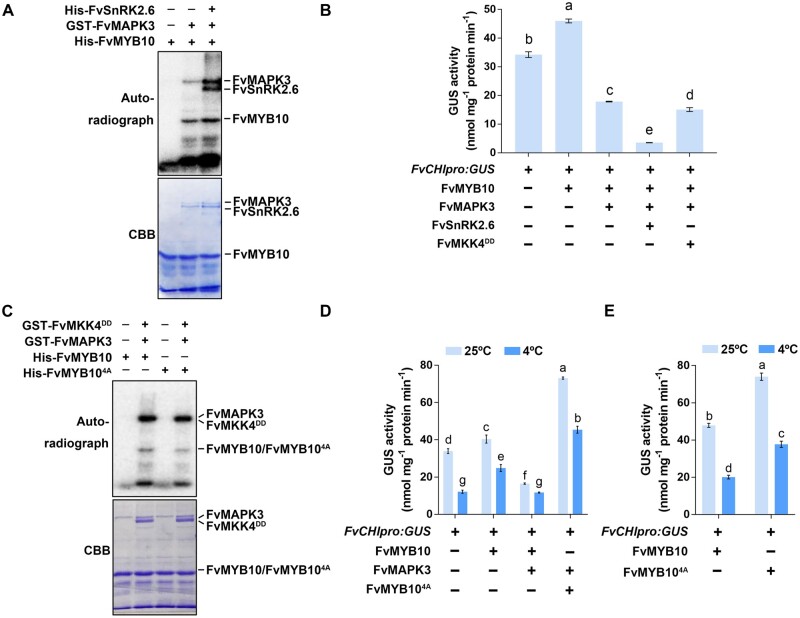Figure 8.
The FvSnRK2.6–FvMAPK3 module decreases the transcriptional activity of FvMYB10. A, FvSnRK2.6 increases the FvMAPK3-mediated phosphorylation of FvMYB10. Recombinant His-FvSnRK2.6, GST-FvMAPK3, and His-FvMYB10 proteins were mixed for in vitro kinase assays. Phosphorylated FvMYB10 was visualized by autoradiography (top). Recombinant FvSnRK2.6, FvMAPK3, and FvMYB10 proteins were detected by CBB staining (bottom). B, Detecting changes in FvMYB10 transcriptional activity. FvMKK4DD, FvSnRK2.6, FvMAPK3, and FvMYB10 were used as effector constructs and co-transformed with the FvCHIpro:GUS reporter. Statistically significant differences between samples were determined by Tukey’s test; significant differences at the P < 0.05 level are indicated by different letters. Values are means ± sem of three biological replicates. C, Phosphorylation analysis of FvMYB10 and its mutant form FvMYB104A. Purified recombinant GST-FvMKK4DD, GST-FvMAPK3, His-FvMYB10, and His-FvMYB104A proteins were mixed in kinase reaction buffer to detect the effects of the FvMKK4DD–FvMAPK3 module on the phosphorylation levels of FvMYB10 and FvMYB104A. The autoradiograph (top) and CBB staining (bottom) are shown. D, Detecting the effects of low temperature on FvMYB10 and FvMYB104A transcriptional activity. FvMAPK3, FvMYB10, and FvMYB104A were used as effector constructs and co-transformed with the FvCHIpro:GUS reporter. After 3 days, fruits were transferred to 4°C for 24 h or maintained at the control temperature of 25°C. Values are means ± sem of three biological replicates. Statistically significant differences between samples were determined by Tukey’s test; significant differences at the P < 0.05 level are indicated by different letters. E, The transcriptional activity of FvMYB104A is higher than that of FvMYB10. FvMYB10, FvMYB104A, and FvCHIpro:GUS were used as effector and reporter constructs co-transformed into big green strawberry fruits. After 3 days, fruits were transferred to 4°C for 24 h or maintained at the control temperature of 25°C. Values are means ± sem of three biological replicates, analyzed by Tukey’s test.

